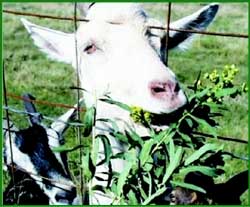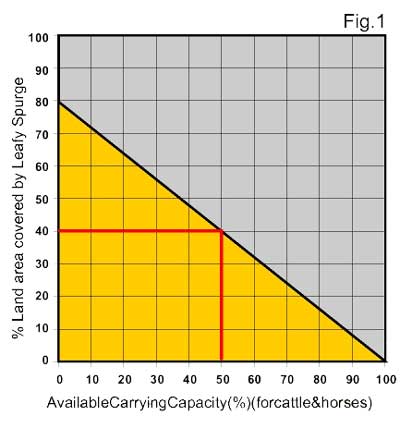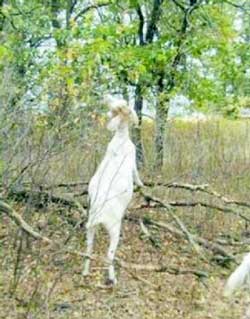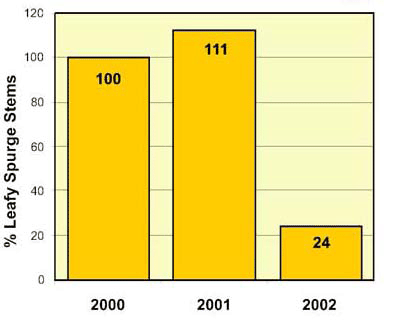Multi-Species Grazing for Leafy Spurge
Multi-species grazing is the practice of using two or more species of livestock on the same grazing system and results in better utilization of the total forage resource.

Why Use Multi-Species Grazing?
The benefit of using multiple species on the same pasture comes from the fact that different animals have different plant preferences. Cattle and horses will not eat leafy spurge. hey avoid leafy spurge because it causes digestive upset, blistering of the mouth and digestive tract, and even death. Sheep and goats on the other hand, suffer no ill effects from eating leafy spurge and even prefer leafy spurge over many other common pasture grasses and legumes. The combination of animal species can provide effective weed control. Table 1 below shows the amount of leafy spurge you can expect each animal species to consume. Goats have the highest preference but both sheep and goats are effective for controlling leafy spurge.
Table 1
Animal |
% Leafy Spurge in Diet |
Cattle |
0 |
Horse |
0 |
Sheep |
40 - 50 |
Goats |
60 - 80 |
When Should You Consider Multi-Species Grazing?
Multi-species grazing will be most practical and economically viable when leafy spurge infestations cover many acres. If your land still has small infrequent patches they are more economically treated with herbicides.
Should You Combine Leafy Spurge Control Methods?
Leafy spurge is a very aggressive plant with no naturally occurring predators in North America. Best results are obtained when two or more management options are used at the same time. This management strategy is called integrated pest management or IPM. So even if you use multi-species grazing the additional use of biological agents and herbicides will enhance and speed recovery.
The Cost of Doing Nothing
If you decide not to control leafy spurge it still costs you money. Leafy spurge infestations decrease carrying capacities of pasture land, decrease land values, decrease ecological diversity and impact water holding capacities of soils.
Figure 1 shows the linear relationship between the percentage of land covered with leafy spurge and its effect on carrying capacity for cattle and horses. If 40 percent of a pasture is covered with leafy spurge it will reduce the carrying capacity by 50 percent.

Table 2 shows the profit or loss of leafy spurge treatment or non-treatment over a 10 year period on the same 100 infested acres. (For purposes of comparison, it was assumed that the land had a spurge 90 free carrying capacity of 25 head of cattle for 4 months)
In the first example a cattle producer has chosen not to treat the leafy spurge and has lost 68 percent of his carrying capacity. In other words about 55 percent of the pasture is covered with spurge. (See Figure 1). Over ten years this lost carrying capacity will cost the producer $15,300 in lost revenues. As well, an uncontrolled infestation of spurge will double in size every 10 years. This producer will continue to lose carrying capacity.
- If a cattle producer treated the pasture twice every year with 2,4-D it is expected that he could gain back about 50% of the lost carrying capacity. However, the cost of the herbicide treatment outweighs the income from the gained carrying capacity by $16,270.
- If a producer chooses to upgrade the fence and uses multi-species grazing he may reach a profitable level. The amount of profit or loss is dependent on the cost of the fencing upgrade and the amount of recovered carrying capacity. In the examples in Table 2, a 76 percent recovery is used for demonstration purposes. Studies, however, have shown that multi-species grazing can recover over 90 percent of the carrying capacity within 5 years. In this case profits would be higher than those indicated in Table 2.
Table 2
Treatment |
No treatment (with 68% lost carrying capacity) |
2,4-D treatment 2 times per year (recover 50% of the carrying capacity) |
Upgrade fence with 5 ft. steel mesh and graze goats (recover 76% of the carrying capacity) |
Upgrade 3 strand barb with 2 strand electric and graze goats (recover 76% of the carrying capacity) |
Upgrade 2 strand electric to 5 strand electric and graze goats (recover 76% of the carrying capacity) |
Profit / Loss |
$15,300.00 LOSS |
$16,270.00 LOSS |
$2,488.90 LOSS |
$3,078.20 PROFIT |
$3,604.60 PROFIT |
Getting Started
Fencing Requirements
Sheep and goats require additional fencing over that used for cattle and horses. The type of fence upgrade required depends on what kind of fence currently exists and what fits best into your system. Your fencing choice influences the total cost of implementing a multi-species grazing system.
Table 3 shows the costs of upgrading a fenced 100-acre pasture. Costs represented are for materials only.
Table 3
| Existing Fence | Barbwire | 3 Strand Barbwire | 2 Strand Electric | Barbwire |
| Upgrade | 5 ft. Steel mesh | 2 additional strands, electric ground rods, and energizer | 3 additional strands, electric | 39 inch page wire |
| Cost | $4,757.00 | $1,506.20 | $994.96 | $3,384.68 |
Predator Control
Sheep and goats require some form of predator control. Fences such as page wire or 5 strand electric will provide some predator control but cannot be relied on solely. Llamas, donkeys and/or guard dogs are typical choices available. When the sheep or goats are grazed with the cattle, that is not in a leader/follower situation, the cattle will also provide some predator control but again cannot be relied on as the sole predator control mechanism.
Should I Use a Continuous or Rotational Grazing System?
Studies indicate that continuous grazing provides the quickest control but rotational grazing is nearly as good. Choose whichever system is going to work best for your operation. It is important to graze the leafy spurge before it sets seed. When using rotational grazing try to get through all of the paddocks by mid July. The leafy spurge will regrow after this first grazing and should be re-grazed one or two more times by fall.
How Many Animals Do I Need?
Stocking rates will depend on the density of your spurge infestation. Leafy spurge infestations may vary from 400 stems/m2 to < 30 stems/m2. It also depends on how much other favorable forage or browse is available. Goats in particular will use a significant amount of browse if it is available. When spurge infestations are light to moderate, 1 goat/sheep per acre grazed over a 4 month period will significantly reduce the spurge in 3 to 5 years. Heavier infestations, high proportions of bush, or shorter grazing periods may require more than 1 goat/sheep per acre.
As the leafy spurge is brought under control, you may need to decrease the goat or sheep stocking rate if you do not want them to overlap the dietary preferences of your other livestock. Table 4 below indicates the dietary overlap with cattle and horses provided the sheep and goats have their preferred forage and browse available. However, if preferred forage and browse are not available they will consume the same diet as your cattle or horses so dietary overlap can be as high as 100 percent.
Table 4
| Animal | Dietary Overlap with Cattle |
| Sheep | 20 - 35% |
| Goats | 5 - 20% |
What Other Benefits Might You Expect When Using Multi-Species Grazing?
Goats and sheep not only eat leafy spurge, they also use other plants that cattle and horses don't eat. Brush is a good example. Sheep and goats in particular, will use a high percentage of woody browse in their diet if it is available. Examples of species browsed by sheep and goats include aspen suckers, buckbrush, hazel scrub, and wolf willow.
Sheep and goats are also forb eaters. This means many plants in the pasture like absinthe, sage, and thistle can be brought under control by the addition of sheep or goats to the system.
When only one species of livestock are grazed in a system, some food resources are wasted. The unused plants may come to dominate the pasture because they are not kept in check by grazing or browsing. Multi-species grazing can help balance both resource utilization and ecological balance.
How Long Will It Take To Get Control?
Leafy Spurge is not very resistant to grazing. Studies have shown that in 3 to 5 years significant stem reductions will occur. This bar graph shows the reductions that occurred over three years at a project north of Wawanesa, Manitoba. Notice in Figure 2, that in year two, the number of stems actually increased. Observations however, showed that the stems were smaller, weaker and bloomed later, or not at all. By year three the stem densities had been reduced by 76 percent.

Will I Need To Use Multi-Species Grazing Forever?
A study in North Dakota has shown that it takes about 5 years of multi-species grazing to reduce leafy spurge by up to 98 percent. At this point you may reduce or even eliminate the sheep or goats from the system. No one knows how long the treatment will last, but there will be lag time before the leafy spurge reaches critical population densities again. Since the remaining leafy spurge will begin to re-infest the pasture, an alternate control program should be implemented, such as spot spraying with herbicides.


